Vector kink-dark complex solitons in a threecomponent Bose-Einstein condensate
2021-05-13YanLiYanHongQinLiChenZhaoZhanYingYangandWenLiYang
Yan Li,Yan-Hong Qin,Li-Chen Zhao,2,3,Zhan-Ying Yang,2,3 and Wen-Li Yang,2,3
1 School of Physics,Northwest University,Xi’an 710127,China
2 Shaanxi Key Laboratory for Theoretical Physics Frontiers Xi’an 710127,China
3 Peng Huanwu Center for Fundamental Theory,Xi’an 710127,China
Abstract We investigate kink-dark complex solitons (KDCSs) in a three-component Bose-Einstein condensate (BEC) with repulsive interactions and pair-transition (PT) effects.Soliton profiles critically depend on the phase differences between dark solitons excitation elements.We report a type of kink-dark soliton profile which shows a droplet-bubble-droplet with a density dip,in sharp contrast to previously studied bubble-droplets.The interaction between two KDCSs is further investigated.It demonstrates some striking particle transition behaviours during their collision processes,while soliton profiles survive after the collision.Additionally,we exhibit the state transition dynamics between a kink soliton and a dark soliton.These results suggest that PT effects can induce more abundant complex solitons dynamics in multi-component BEC.
Keywords: kink-dark complex solitons,pair-transition effects,three-component Bose-Einstein condensate
1.Introduction
Multicomponent Bose-Einstein condensates (BEC) provides a particularly versatile platform for the investigation of vector solitons both experimentally and theoretically [1].Vector solitons in two-component BEC have been the focus of intense research efforts,such as dark-dark solitons [2],dark-bright solitons [3-5],bright-bright solitons [6,7],kink-anti-kink solitons and bubble-droplets[8].Interestingly,it was shown that pair-transition (PT) effects can bring much abundant nonlinear waves in two-component systems [9-18],since the constraint conditions on nonlinear interactions are distinctive from the ones in Manakov model [19].This provides possibilities to investigate nonlinear waves exactly and analytically in the integrable systems other than the Manakov case.
Vector solitons in three-component BEC have also attracted much attention in recent years [20-25].Especially,it was reported that three-component solitons have been generated experimentally,i.e.the dark-bright-bright and dark-darkbright solitons[24,25].Those developments and results in twocomponent BECs with PT effects [13-16,18] motivate us to look for more exotic soliton excitations in a three-component BEC with PT effects.The dynamical equation for the systems is also quite different from the ones studied previously [20-24],due to much more possible transition channels.These characters hint that there could be some striking transition processes in a three-component BEC with PT effects.
In this paper,we present kink-dark complex solitons(KDCSs) in a three-component repulsive BEC with PT effects.The different profiles of KDCSs are classified qualitatively to three distinctive types according to the relative phases between the excitation elements.Especially,we report a striking profile for a bubble or a droplet with a density dip.We further characterize the topological properties of them in a complex space to address the phase jumps.Then we investigate the interactions between two KDCSs.The results show elastic collisions,but many particles transit to the other components in the collision region and transit back perfectly after the collision.Additionally,we find that state transitions between a kink soliton and a dark soliton will occur under certain parameter conditions,accompanied by particle transition among three components.The results would enrich our knowledge on nonlinear excitations in many coupled nonlinear systems with transition coupling effects.
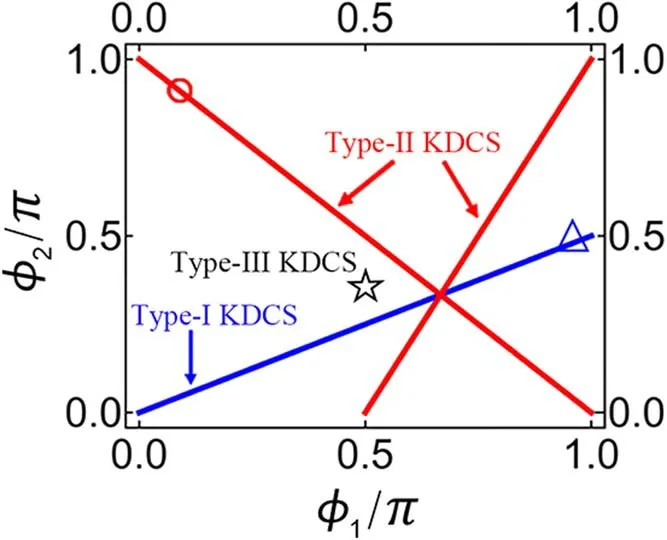
Figure 1.Phase diagram for different types of KDCS profiles.It is shown in two relative phases φ1 and φ2.It is seen that there are three types of KDCS excitations.The blue line corresponds to the type-I KDCS profiles:a bubble or droplet with a density dip in the center of density distribution.The red lines correspond to the type-II KDCS profiles: a density dip on the right or left side of a bubble (droplet).The regime except the points on the three lines corresponds to the type-III KDCS profiles:the general kink-dark complex solitons.For the intersection of the three lines,the density profiles are similar to three dark solitons.The blue triangle,red hollow circle,black pentagram in the phase diagram correspond to the first,the second and the third panel in figure 2,respectively.The parameters are v1=v2=v3=0,d1=-20,d2=0,d3=20.
The paper is organized as follows.In section 2,we present KDCSs solutions for a three-component BEC with PT effects.These different profiles of KDCSs are classified qualitatively to three distinctive types and their topological phases are investigated.In section 3,we further investigate the interaction between two KDCSs.In section 4,we demonstrate state transitions between a kink soliton and a dark soliton.The conclusion and discussion are given in section 5.
2.The physical model and KDCSs solution
One-dimensional three-component BEC system with particle transition can be described by the Hamiltonian


where q1(x,t),q2(x,t),q3(x,t) are three components’ meanfield wave functions.The symbol overbar represents the complex conjugation.The soliton solutions for the above model can be obtained by the proper linear superposition of solutions for scalar NLSE=0,using the method of linear transformation [9,11].The KDCS solutions can be constructed by the following forms:
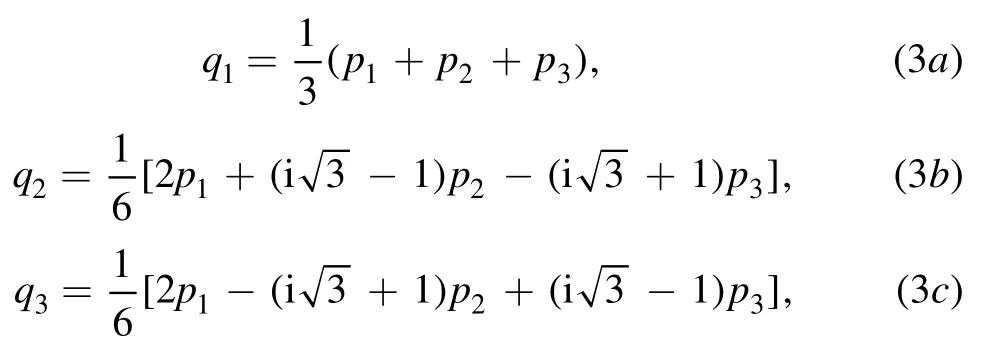
where pj(x,t)(j=1,2,3) refers to three excitation elements for constructing KDCS solution.We set pjas single-valley dark soliton solutions of the scalar repulsive NLSE.The explicit expressions for pjcan be written as follows [30]
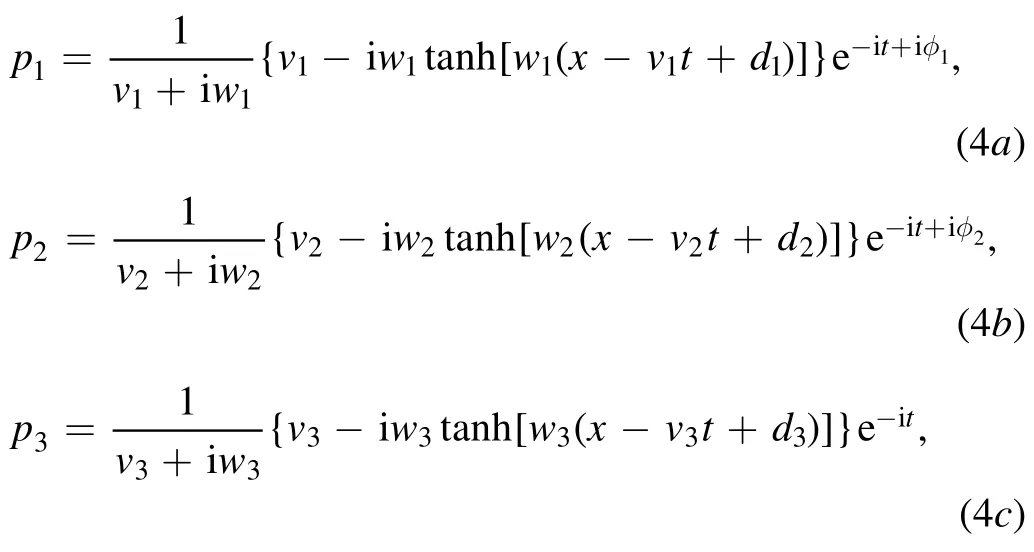
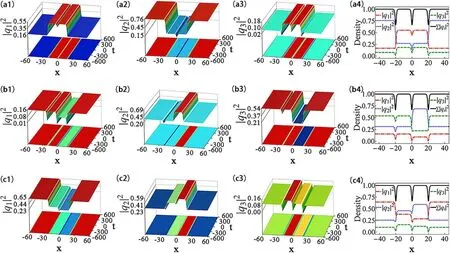
Figure 2.Three different density profiles for the KDCSs in three-component coupled systems.(a1)-(a4) The density profiles of a dropletbubble-droplet with a density dip.It corresponds to the blue triangle in figure 1.The parameters are φ1=0.93π and φ2=0.5φ1.(b1)-(b4)The density profiles of a dark soliton located on the left side of a bubble-droplet-bubble.It corresponds to the red circle in figure 1.The parameters are φ1=0.1π and φ2=0.9π.(c1)-(c4)The density profiles of the general form of KDCSs.It corresponds to the black pentagram in figure 1.The parameters are φ1=0.5π and φ2=0.3π.The red dashed-dotted line,blue dotted line,green dashed line and black solid line correspond to the density distributions of component q1,component q2,component q3,and sum of them respectively.The other parameters are setting same as in figure 1.
vjis the velocity of each excitation element,which cannot exceed sound speed(|vj|<1).is related to the width of excitation element.djis used to adjust initial position of each element.φ1and φ2are introduced to change initial phase of excitation elements p1and p2,respectively.Particularly,when three excitation elements have same velocity,i.e.v1=v2=v3,the solution equations (3) will allow the solitons’ profiles in three components to possess the characteristics of the well-known kink soliton [8,16,31-34] and the dark soliton[3,4,35-38].Therefore,this kind of solitons is so-called KDCSs.
It is worth noting that when v1=v2=v3,φ1is relative phase between excitation elements p1and p3,and φ2is relative phase between p2and p3.Interestingly,the variations of these two relative phases have important effects on density profiles of KDCS.The density profiles of KDCS can be qualitatively classified into three distinctive types,according to the position and non-uniform background of dark soliton part included in density profile of a KDCS.The explicit conditions for them are summarized in figure 1.It is obtained from variable relative phases φ1,2with fixed soliton’s amplitude and velocity.Similar phase diagrams can be obtained in other cases.
Type II: There are two parameter conditions for type-II KDCS,which shows a dark soliton on the one side of a bubble or a droplet.When φ2=2φ1-π,a dark soliton is on the right of a bubble or a droplet for a KDCS; when φ2=-φ1+π,a dark soliton is on the left of a bubble or a droplet.We show a typical example of type-II KDCS in the second panel of figure 2 with setting parameters φ1=0.1π and φ2=0.9π,corresponding to the red hollow circle on the red solid line in figure 1.Figures 2(b1)-(b3) are the density distributions of three components.Figure 2(b4) shows the corresponding density profiles.Obviously,the dark soliton is located on the left of a bubble(droplet)in the first component and the third component (the second component).

Figure 3.The three-step structure of the phase jump and its corresponding magnetic fields in the complex plane for the stationary type-I KDCS.(a)-(c)Correspond to the component q1,component q2 and component q3 respectively.The point-like magnetic fields are located at(-20.3,±1.0),(0.0,±1.1),(20.3,±1.0) for the component q1; at (-19.7,±1.1),(0.0,±0.9),(19.7,±1.1) for the component q2; at(-20.2,±0.3),(0.0,±0.7),(20.2,±0.3) for the component q3.The period is π along the imaginary axis.The parameters are same as the type-I KDCS in figures 2(a1)-(a3).
Type III: When the settings of φ1and φ2do not satisfy above three parameter relations,the solution(3)will show the type-III KDCS profiles,for which the background of dark soliton part is non-uniform.They exist in the region except the points on the blue or the red lines in figure 1.We can see that the parameter space for this case is much larger compared to above cases.Thus,this kind of soliton excitations can be considered as the general density profiles of KDCS.For example,the third panel of figure 2 displays the spatialtemporal density distributions by choosing parameters φ1=0.5π and φ2=0.3π,(c1)-(c3) for the first component,the second component and the third component,respectively.This corresponds to the black pentagram in figure 1.Figure 2(c4) presents the density profiles clearly.It is seen that type-III KDCS profiles show the combination of multikink and antikink structure with a density‘dip’at each‘step’,which is different from the multikink configurations supported by scalar field models [39,40].
The above studies have shown the abundant KDCS profiles generated by the linear superposition of three excitation elements.Recently,the topological phase of dark solitons had been firstly investigated in [41].It was reported that the phase jump across its density dips can be well understood by the topological vector potential in complex plane.Then,we would like to investigate the phase property of obtained KDCS solutions (3).
As an example,we study phase distribution of stationary type-I KDCSs and its topological vector potential A with using the methods of [41].Here,the phase value of a KDCS in each component be referred to as θj,calculated asθj=arg[qj].The results have been shown in figure 3 with blue solid line,(a)-(c) corresponding to the density distribution in figures 2(a1)-(a3),respectively.It is seen that the phase jump value is±π for each component.Particularly,the phase variation exhibits an apparent three-step structure for a KDCS,which is different from the single step structure of scalar dark solitons discussed previously [35,36].It is also distinctive from the static triple-valley dark soliton,for which phase jump value is 3π accompanied by three times phase jump across the three valley [41].Then,we want to explain the topology underlying their phase jumps.We first get the integrand function in the area integralThen,we introduce a functionF(z)j,which is an analytic extension ofF(x)jwith x replaced by a complex number z=x+iy.Based on the results of [41] we can get that the vector potential Aj=Re [F(z)j]ex-Im[F(z)j]ey.Therefore,we can understand the topology of KDCSs by their vector potential Ajand the corresponding magnetic filed B=∇×A can be acquired.The directions of flux lead to a positive or negative phase jump.We plot their corresponding magnetic fields in figures 3(a1)-(a3)with red symbols.The positive and negative magnetic flux emerge in pairs and locate on the imaginary axis with period π.The point-like magnetic fields are scattered on three separate lines at xj(j=1,2,3).For the component q1,the associated phase steps are Δ1=0.35π,Δ2=0.30π,Δ3=0.35π.On the contrary,the direction of flux is opposite to that of the first component,and three phase steps are Δ1=-0.28π,Δ2=-0.44π,Δ3=-0.28π for the component q2.Particularly,for the component q3,there are two pairs of magnetic fields with the same direction and one with opposite direction,and the associated phase steps are Δ1=0.78π,Δ2=-0.56π,Δ3=0.78π,respectively.The phases of other types of KDCSs behave similarly.
Based on the above results on density profiles and the topological phase properties for different types of KDCSs,one can expect that the interaction between multi-KDCSs can bring much more fascinating dynamical behaviours.For simplicity,we would like to discuss the interaction between two of them with the aid of two-dark solitons elements.
3.The interaction between the KDCSs
To study the interaction between two KDCSs,we set the three excitation elements pjas two-dark solitons of scalar NLSE [30]:
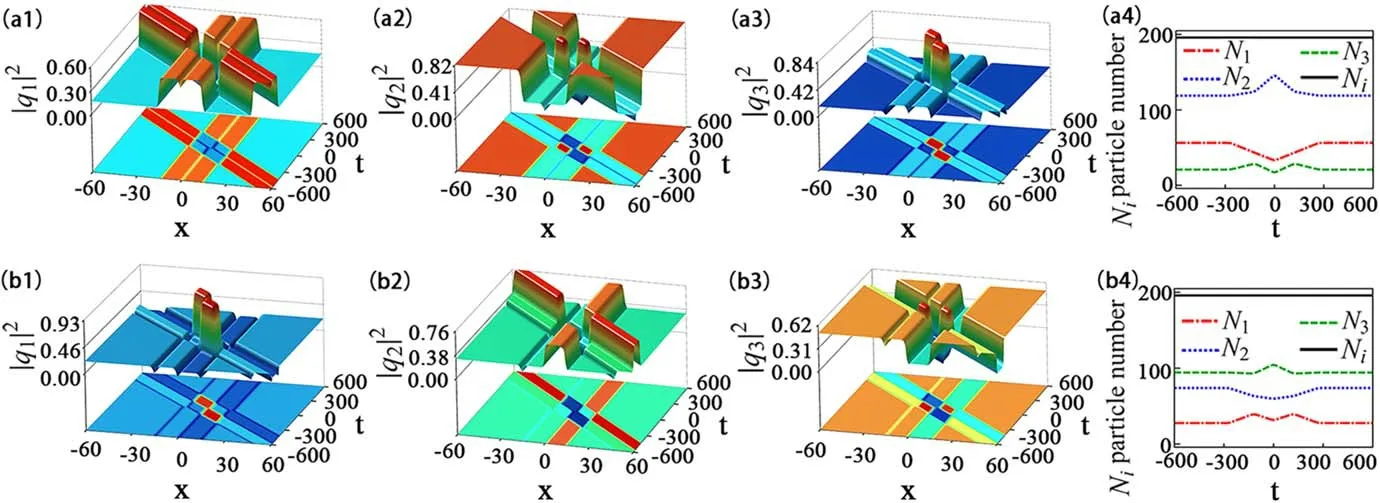
Figure 4.The collision of two KDCSs.In top panel:the collision between two type-I KDCSs.The parameters are φ1=0.93π,φ2=0.5φ1.In bottom panel:the collision between type-II and type-III KDCSs.The parameters are φ1=0.1π,φ2=0.9π.It is seen that the whole collision is elastic,but striking particle transition emerges among the three components during the collision process.The density evolutions are correspond to the component q1,component q2 and component q3 from the top to bottom.The other other parameters are v1=0,v2=-0.1,d1,1=d1,2=-15,d2,1=d2,2=0,d3,1=d3,2=15.
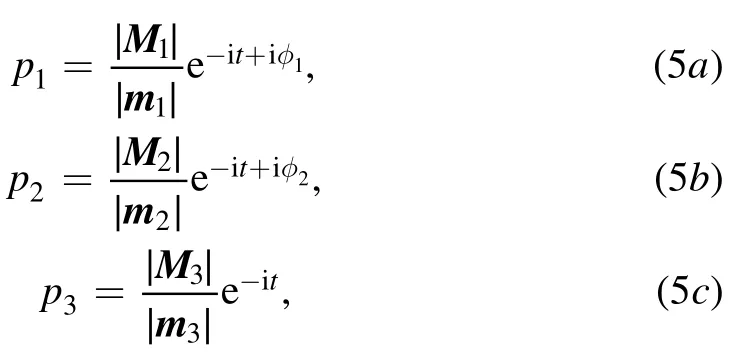
where

When the velocities of two KDCSs are different,the solution equations (3) admits one to study their collision dynamics.As an example,we firstly investigate the collision dynamics between two type-I KDCSs in the top panel of figure 4,(a1)-(a3) corresponding to the density evolutions of component q1,component q2,component q3,respectively.To demonstrate the particle transition processes,we numerically calculate the variations of particle numbers with the time evolution of the three components in figure 4(a4).We defineas the particle number of the component qj.Here,we only consider the integral of particle number in interval [-100,100] where particle transition happens.It is seen that the interaction between two droplets leads to a sharp particle number drop during the collision for the first component(red dashed-dotted line),but the particle number increase dramatically in the collision area of two bubbles for the second component (blue dotted line).Interestingly,both the increase and decrease of particle number are emerged during the collision process of two droplets in the third component (green dashed line).It means that striking particle transition happens among three components,induced by the PT effects.While the whole particle number of the system is conserved(black solid line).Strikingly,the density distributions of KDCSs in three components are rapid return to the initial structures after the collision and the particle numbers are equal to the initial states.Therefore,the interaction of KDCSs is elastic.In other words,the collisions of two droplet-bubble-droplet states obtained herein is elastic,in sharp contrast to the interactions of quantum droplets in[42,43]which demonstrated merger or separation dynamics depending on the speeds of the collision pairs.
We further display the interaction between a type-II KDCS and a type-III KDCS in the bottom panel of figure 4,(b1)-(b3) for the density evolutions of component q1,component q2,component q3,respectively.To understand the particle transition dynamics between three components during the collision process,we also calculate the particle number of each component with the time evolution in figure 4(b4).The particle number are also calculated asWe can see that a large number of particles of the component q2are transferred to the component q1and q3during the collision process of two KDCSs.The density profiles of type-II KDCS and type-III KDCS all survive very well after the collision.It shows a perfect particle transition dynamics caused by the PT effects among the three-component repulsive BEC.
In above discussions,by setting the identical velocities of three dark soliton elements,we have demonstrated the rich KDCSs profiles and their fascinating interaction dynamics.In addition,we note that there are striking state transition dynamics when the velocities of three elements are different.We will discuss such soliton dynamical behaviours in the following.
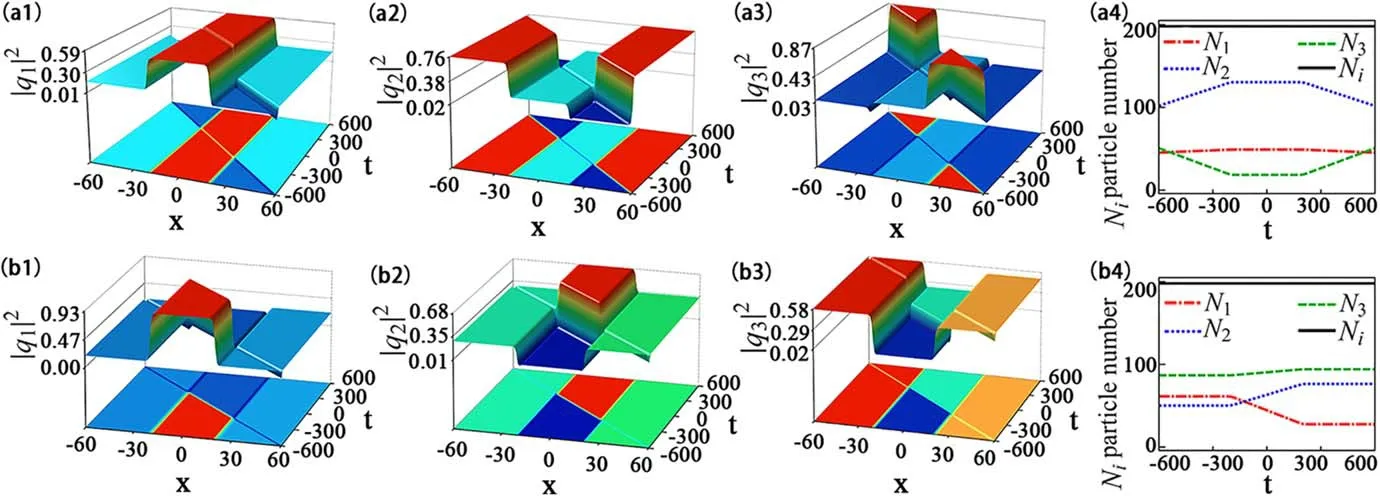
Figure 5.State transition between dark soliton and kink.(a1)-(a3):the collision between a kink and a kink pair.It is seen that the kink soliton isconverted into a dark soliton in their collision region.The parameters are - arcsinv2.In (b1)-(b3): the interaction between a dark soliton and a kink pair.For this case,the dark soliton is transformed to a kink in their collision region.The parameters are set asφ1 = 0.8π ,φ2 = 0.9π - arcsinv2.The other other parameters are v1=v3=0,v2=-0.1,d1=-20,d2=0,d3=20.
4.State transition between kink and dark soliton
When the velocities of three elements of equations (4) are different,the solution equations (3) admits more abundant soliton dynamical behaviours.For simplicity,we investigate soliton dynamics with v1=v3≠v2of equations (4).For this case,the interaction between a kink(dark soliton)and a kink pair could be investigated.As an example,we firstly show the collision between a kink soliton and a kink pair in the top panel of figure 5,(a1)-(a3) corresponding to the component q1,q2and q3respectively.The parameters arev1=v3=0,v2= - 0.1,φ2=-arcsinv2.Remarkably,the profiles of solitons undergo dramatic change during the collision processes in three components simultaneously.We can see that when a kink collides with a kink pair,it is changed into a dark soliton in their collision region.The density distribution structures in their collision area can also be regarded as a type-I KDCS.However,after the collision,the kink is transformed into an anti-kink while the kink pair becomes a new one for each component.Such state transition dynamics is in sharp contrast to the collision dynamics of two KDCSs displayed in figure 4,for which soliton profiles are kept well after the collision.To understand their interaction process,the temporal evolutions of particle numbers are presented in figure 5(a4).It is numerically calculated in the region where particle transition happensVery interestingly,the particle population keeps constant in the interplay region for each component but it is undergoing change before and after collision.It demonstrates that,in the presence of PT effect,the particle number of each component can be non-conserved,but the whole particles population is always conserved for the system.Such state transition dynamics cannot be observed in two-component cases [14,16].
We secondly study the interaction between a dark soliton and a kink pair.A typical example for their collision are illustrated in the bottom panel of figure 5 with parametersv1=v3= 0,v2= - 0.1,φ1= 0.8π,φ2= 0.9π-arcsinv2.Figures 5(b1)-(b3) correspond to density distributions of the component q1,q2and q3respectively.Particularly,the dark soliton is altered to a kink when it meets a kink pair in each component.After the collision,it still exhibits a dark soliton profile but the background density is changed.Simultaneously,the kink pair transits to be a new one which is distinguished from the initial state.We further demonstrate the time-evolutions of the particle populations of three component in figure 5(b4),It is seen that,after the collision,the particle numbers increase for component q2and q3but it decreases for q1caused by the PT effects among three components.Obviously,the particle transition process is quite different from the case in the top panel of figure 5.These results provide possibilities to explore the abundant nonlinear excitations and fascinating solitons’ dynamics in multi-component BEC.
5.Conclusion
In this paper,we obtain KDCSs in a repulsive three-component BEC with PT effects.The profiles of KDCSs are sensitive to the phase difference of three dark soliton elements.Based on this,they can be classified qualitatively to three distinctive types.The topological phase of KDCSs shows three times-step structure of the phase jump.The phase jump value of stationary KDCS is π.We further demonstrate the elastic collision dynamics of two KDCSs,where striking transition behaviours emerge induced by PT effects during the collision process.Moreover,we show that the state transition between a kink and a dark soliton could be generated,induced by the collision between a dark soliton(kink)and a kink pair.The reasons of these striking collision dynamics come from the PT effects.The particle number of each component can be non-conserved,but the whole particles population is always conserved for the system.These results provide possibilities to explore the abundant nonlinear excitations and fascinating solitons’ dynamics in multicomponent BEC.
Acknowledgments
This work is supported by the National Natural Science Foundation of China (Contract No.12 022 513,11 775 176,11 947 301),the Major Basic Research Program of Natural Science of Shaanxi Province (Grant No.2018KJXX-094),the Scientific Research Program Funded by Shaanxi Provincial Education Department(Grant No.20JK0872 and 2017KCT-12).
杂志排行
Communications in Theoretical Physics的其它文章
- Insight into the chemomechanical coupling mechanism of kinesin molecular motors
- A pedagogical review on solvable irrelevant deformations of 2D quantum field theory
- Ab initio study of the effects of helium on the mechanical properties of different erbium hydrides
- Interface water-induced hydrophobic carbon chain unfolding in water
- A simplified Parisi ansatz
- Electron acoustic solitary waves in unmagnetized nonthermal plasmas
